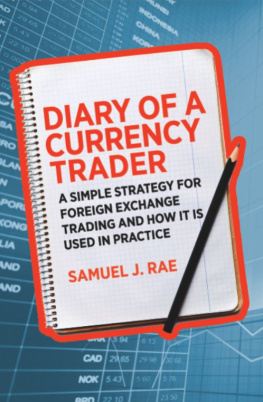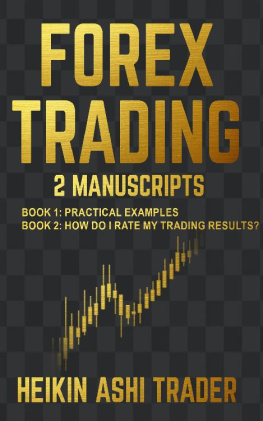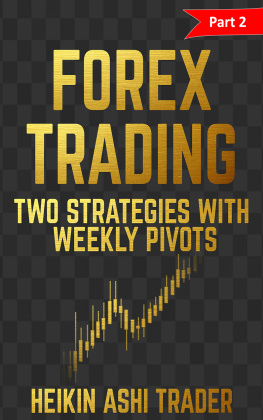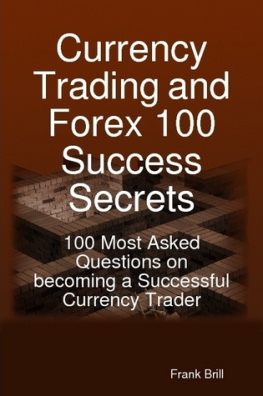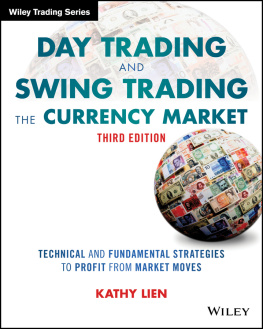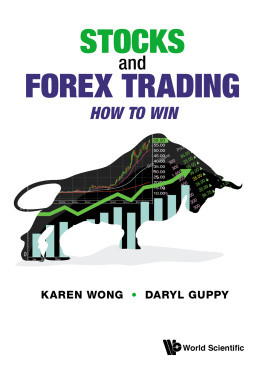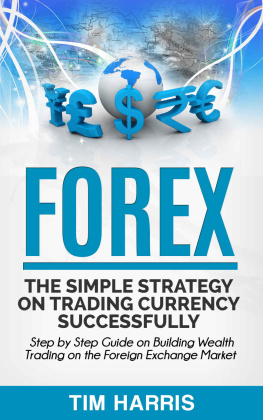Id like to be clear from the start. This book is not a beginners guide to foreign exchange or a how-to manual that will tell you how to follow a definite strategy. There are countless other books and online resources available that explain the basics of forex trading, or claim to present a system that guarantees profitability. This is not one of them. This book is for anyone who wants to know exactly how one trader operates and profits in the foreign exchange market.
As such, if you are new to forex and you are not familiar with the way the market or individual trades work, down to such terms as pips and pairs, then I recommend you read up on this first. Similarly, my method employs candlestick charts and basic technical analysis. If you are not familiar with these concepts then you will need to obtain this knowledge before you read on. I have included a Useful resources section at the end of the book in which I suggest where you can start.
There are many different ways to achieve success in the currency markets and my approach is just an example. It should be taken as such. Rather than try to convince anyone that they should follow my methods, I want this book to show the concepts and the principles I apply to my trading. Risk management, trading psychology and constant self-assessment are qualities that very few unsuccessful traders possess, and all successful traders share. Developing these qualities is much more important than learning how to use a particular indicator, or having a feel for what combination of signals implies entry.
In order to give a complete and unaltered insight into my trading life I have structured this book in the form of a diary. The first half of the book lays out my strategy; from my risk management principles, to how I think and feel about trading, to what patterns I use the most and why. The second half covers three months of my own personal trading; every trade, win or lose, and my reasoning for and reaction to each. Before I wrote the book I had no idea how the three months of trading would turn out and my analysis is presented as it was performed.
At the end of the book, along with the list of recommended resources, is an appendix with charts showing the price activity of three currency pairs in 2011. I make reference to these charts in my trading diary.
Introduction
One thing that always interests me is how other people trade. Be it stocks, options or currencies, everyone has their own style, methods and approach. It amazes me what sparse literature is available that covers these things in any depth and this is my attempt to redress the balance.
If you have spent any amount of time immersed in the trading world, or perhaps even if you havent, you will have seen a huge number of books titled This Winning Strategy, or That Winning Strategy. I myself have probably read 20 different books of this type, under different guises, and at the end of each one I am always left thinking, Well, show me then! Having written Diary of a Currency Trader, I now know why many authors choose to tell people about their strategy but not show it in action.
If Im being honest, when I sat down to write this book I had no idea what I was getting into. The trading itself was of course normal to me. The reflection on each trade, again, was normal. Putting it all down on paper in a way that somebody else might understand, on the other hand, was not something I was accustomed to.
A strategy that you follow every day can seem relatively simple in your head, but when it comes to deconstructing it and presenting it to someone else it ceases to be so. On top of this, sitting at your computer and writing about your winners is an enjoyable task, but doing the same with your losers is not.
I also had to work hard not to let the thought that I was going to be writing my diary each evening affect my trading decisions. One of the things I talk about a little later on in the book is how you shouldnt let the outcome of one trade influence another, but this is a very difficult thing to do if after a string of losers you know you will be sitting down and dissecting the trades, writing them up for others to read about!
Anyway, I got through it, and this is the finished piece. My aim was to write a book that would illustrate what it is like to trade, and what one particular trader goes through on a daily basis. I think I have succeeded.
If you take just one thing away with you I hope its that retail foreign exchange trading is difficult and emotionally taxing, but doable. You do not need God-given talent, nor do you need expensive mentorship or sophisticated computer programs. With the availability of mini lot trading you dont even need vast capital resources. All you need is time, hard work and a sound grasp of risk management principles. In reverse order.
Enjoy.
Chapter One: Birth of a Trader
This chapter looks at me as a trader: how I first got interested in the world of currency trading, where it took me and ultimately how I came to the point I am at today.
I have to start with something of an apology though. I imagine most of you have picked up this book intending to really dig deep into the mechanics of trading foreign currencies for a living. Youve finally found some time to sit down and get stuck in, and here, right at the opening turn, I am first going to subject you to a history lesson.
Heres the good news. This history section is what you might call a small liberty of mine. It is only short. The history of currencies, their birth and life cycle, are a sort of private infatuation for me. From the ancient introduction of coins as a means of value storage, through to the modern day reserve strength of the US dollar, the journey that money has made over the past few thousand years fascinates me, but it often escapes the interest of the general audience. If I mention the Bretton Woods agreement to others I know who are interested in trading, it is as if I have started a race for the door.

